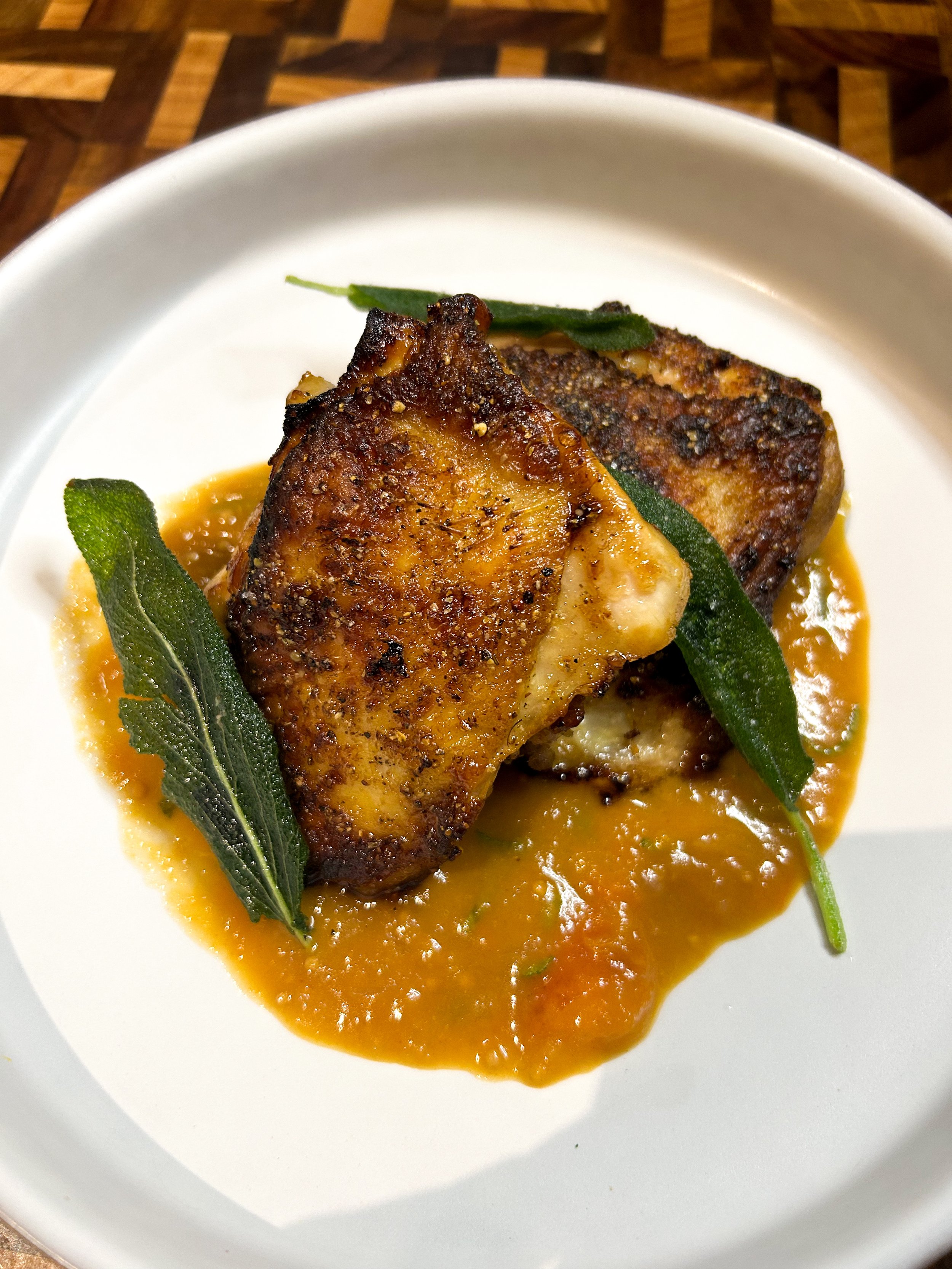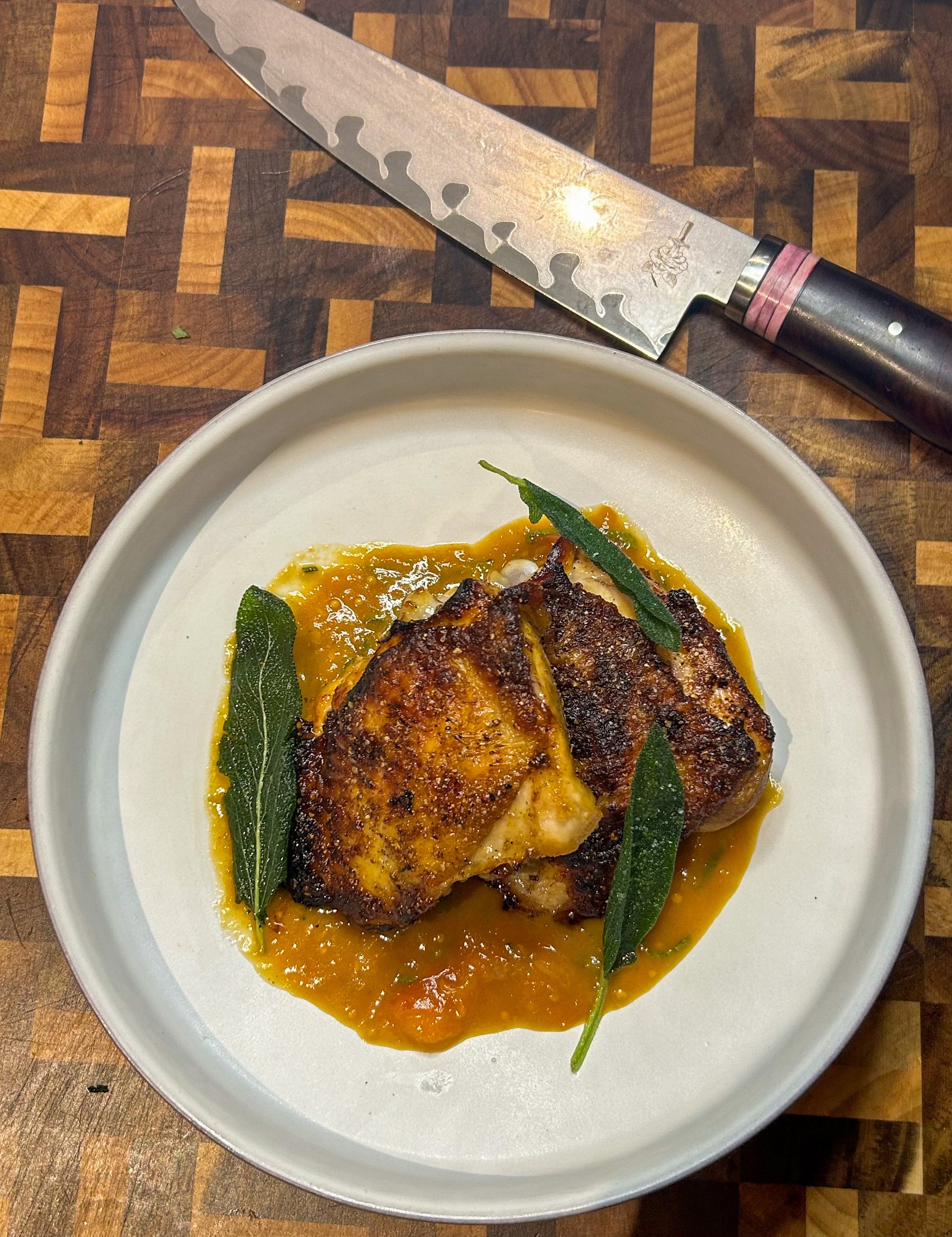Crispy ORange, Apricot + Herb BRINED cHICKEN tHIGHS, aPRICOT + Sage wINE sAUCE, Fried SAGE
The first time I opened a bottle of wine was at nine years old.
Let me explain.
My dad was out of town for work. My mom was at a meeting for a couple of hours, and I was left at home with my then-teenage brothers. I set out to cook my mom a delicious dinner for when she returned home. After rummaging through our pantry shelves and fridge, I pulled out chicken breasts, dried apricots, and dried sage leaves, I’m sure among some other miscellaneous ingredients. I immediately got to work.
If I remember correctly, I think I pounded the chicken breasts to flatten them, chopped up the apricots and made a sort of Thanksgiving-esque sage filling. I then wrapped it up in the chicken and cooked it somehow, some way. I remember hearing my mom’s car pull up and quickly pulling a bottle of pinot grigio from the fridge, opening it up (screwtop, thankfully), and pouring her a glass of wine to accompany her probably very dry, very sad chicken roll-ups. I remember being so proud. I remember looking at it and thinking that I had actually just cooked for the first time. Though I’d spent the past three or so years enthralled by cooking, I had merely whipped cream, made concerning desserts, attempted omelets and assisted my parents when able—I had never really cooked like that, all alone, until that night.
Two years later, I created this website, and though it wasn’t named it at first, it eventually found its way home to “Apricots and Sage,” an ode to that night. I honestly don’t think I’ve ever attempted to recreate it, until now.
Brine wise, this one is sweet, salty, acidic, and very astringent on its own — it will taste really salty. After a good 6-8 hours hanging out with the chicken, though, it infuses just the right amount of flavor into the bird and creates a fantasically juicy end result. I personally think brining chicken thighs more than eight hours just turns them to mush and is unnecessary, but if you must do it overnight, just try to take them out of the brine first thing in the morning and place them in a separate container until you are ready to cook them.
Crispy Orange, Apricot + Herb Brined Chicken Thighs, Apricot + Sage Wine Sauce, Fried Sage
Recipe for 4 chicken thighs
Prep Time: 20 minutes | Rest Time: 4-8 hours | Cook Time: 30 minutes
Orange, Apricot, Herb Brine
3/4 cup freshly squeezed orange juice (about 3 large naval oranges)
1 lemon, juiced
1 cup + 2 tbs. water
1/4 cup white wine vinegar
1 bunch fresh sage leaves
1 sprig fresh rosemary
1 bay leaf
1/2 tbs. black peppercorns
1/2 cup dried apricots, sliced open
1/2 shallot, roughly chopped
3 garlic cloves, peeled and smashed
1 tbs. kosher salt
3 loosely-packed tbs. dark brown sugar
Place all ingredients in a saucepan and bring to a boil. Reduce to a simmer and cook until sugar and salt are dissolved. Let cool completely (can speed up by pouring in a separate dish and placing over an ice bath).
Crispy Chicken Thighs
4 bone-in skin-on chicken thighs
Orange, Apricot, Herb Brine, recipe above
1 tbs. mustard seeds*
8 black peppercorns*
1 tsp. course salt*
1 tsp. dried sage
Canola or a light olive oil
*Can sub for 1 tsp. black pepper, 1 tsp. kosher salt and 1 tsp. ground mustard seeds
Trim excess fat off chicken thighs. In a container or bowl, pour the brine over the chicken thighs to submerge completely. Cover and place in the fridge for 4-8 hours.
Lightly toast the mustard seed and black pepper in a pan until ragrant. Grind the toasted spices and the salt using a mortar and pestle or a spice grinder into a medium grind. Mix in the dried sage.
Dry off the chicken thighs with a paper towel to completely dry them — no need to rinse the brine off. Massage the chicken thighs with the dry mix, AVOIDING the skin. Massage the spice on the flesh underneath the skin and on the meat side of the thighs. The spices will burn on the skin. Lightly salt the skins.
Preheat the oven to 375ºF.
Add a thin, even layer of oil to a cold heavy-bottomed skillet. Turn the heat on medium and immediately add the chicken thighs skin down. Starting from a cold pan will help render out as much fat as possible and slowly crisp up the skini. Cook around 25-30 minutes until the skins are golden brown and crispy. Because of the sugar in the brine, the skin might get darker than anticipated, but it will not taste burnt. Finish in the oven, removing chicken to a rack skin-side up if the chicken drippings have become to dark or the skin is getting too dark. If that is not the case, keeping it in the pan to cook will work. Cook until a thermometer reads 160ºF. Set aside to let rest while you make the sauce.
Apricot-Sage Wine Pan Sauce
1 tbs. olive oil
1/2 shallot, minced
2 garlic cloves, minced
3 fresh apricots
1 bunch fresh sage leaves
1/3 cup dry white wine
1/2 cup chicken stock
1 tbs. dark brown sugar
Salt and pepper to taste
1 1/2 tbs. cold butter
1 tbs. thinly sliced fresh sage leaves
If the remaining bits from the chicken skillet are golden brown, pour out the excess grease and add the minced shallots and garlic. If the remaininig bits are burnt, get a clean pan, heat the tablespoon of olive oil over medium heat, and then add the shallots and garlic. Add a pinch of salt, saute until tender but without adding much color. Turn the heat up to high, add in the sage, apricots, and brown sugar, deglaze with wine making sure to pick up all the bits on the bottom of the pan while stirring, and let reduce until nearly dry. Add in the chicken stock, allow to reduce until the apricots have softened and created a jammy-like sauce. Remove from heat, remove the garlic and sage leaves, and quickly whisk in the cold butter until the sauce is thick enough to coat the back of a spoon. Add the fresh sage leaves and season with salt and pepper to taste. Serve immediately with the chicken thighs and garnish with fried sage leaves (recipe below).
Fried Sage Leaves
Fresh sage leaves, rinsed and dried
Canola or a light olive oil
Salt
Pour oil in a small saucepan to rise up the sides 1 inch. Heat over high heat until a sprinkle of water sizzles. Flash fry the sage leaves until just starting to turn a deeper green color. Remove onto a rack or paper towel. Sprinkle with salt. Sage leaves should be delicate and crispy.




